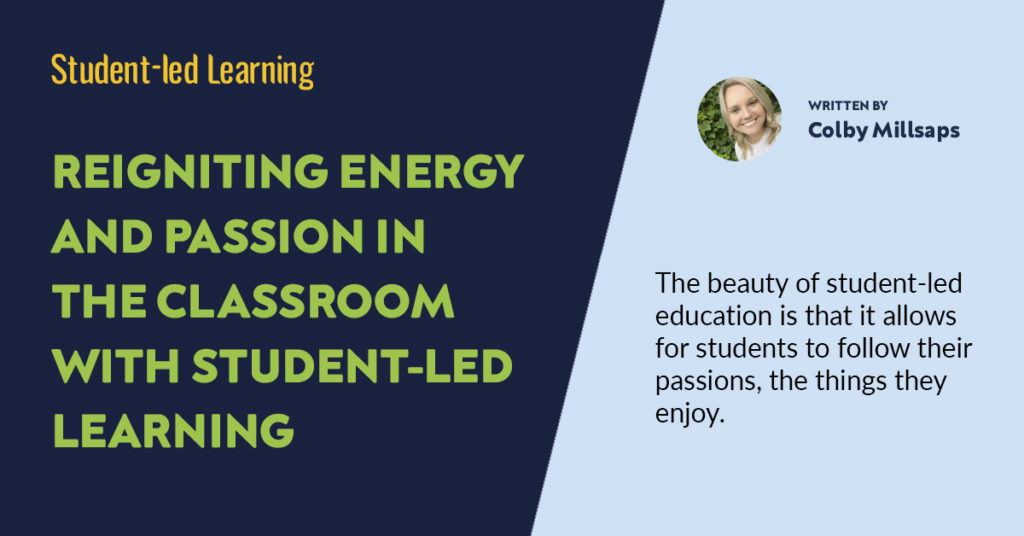Reigniting Energy and Passion in the Classroom with Student-led Learning

I was a deer in the headlights when I was first asked to come up with a question to drive my own individual research for a project that would later be presented to community members and fellow students.
What would I focus on? What was important? What was I supposed to be learning from this experience?
The beauty of student-led education is that it allows for students to follow their passions, the things they enjoy. So at just fifteen years old, I chose to focus on music. What role did music play in the lives of teens in both China and the United States? I could care about this. I could research this. And I threw myself into it.
Looking from the standpoint of an adult years later, I now question my decision. Was that really so important? Other students in the program were researching education systems or other significant topics that had much more social impact. What did researching music have to do with the big picture? However, looking from the standpoint of an educator myself now, I can see just how much this experience helped me to grow. Sure, I learned about different music between cultures and how it impacted teens, but I gained so many other skills – skills that can’t be measured by progress checks and paper tests.
Don’t be afraid to try something new
When I was a student, I can assure you I had no idea what “Project-Based Learning” was or the difference between “student-led” or “teacher-driven” classrooms. I sat in my assigned seat, I answered the right questions, and I did what my teachers asked. But there were times when I was allowed to step out of the box, where the usual expectations weren’t followed to a T, and I can honestly say those experiences didn’t disrupt my learning – they enhanced it.
COVID has flipped education on its head. Any educator can attest to that. As we come off a year of screens and shaky connections, teachers everywhere are scrambling to build back respect and connection with each of their students. There is a time and place for conventional learning methods, and I will be the first to admit that those tried and true methods still work. But now is the time to intersperse some new strategies into the classroom. Many students sit apathetic in classrooms, disengaged and unmotivated to the material in front of them. So how can we get students involved in their learning again? How can we bring back the energy and the passion after such a chaotic year and all the continued challenges? Maybe the answer is simpler than we think..
Have courage
The idea of student-led learning is pretty self-explanatory. That doesn’t mean it’s easy to shift into. Admittedly, student-led learning can be a bit intimidating when you first begin. This goes for both the instructor, who has to relinquish control and trust their students, as well as for the students, who have to develop questions and ideas that are going to drive their own learning. This takes courage and opens up a new opportunity for mutual respect and trust between student and educator. Each party is entering into unfamiliar territory and must rely on one another to make the most of the new opportunities that arise.
Trust
It is the common goal of any instructor to help students become more self-sufficient, beneficial members of society. Allowing them to step into that independent role in the classroom, with the guiding hand of a trusted teacher nearby, will give them the confidence they need to move forward in class and life. Now is the time to trust your students to make their own mistakes and be there to guide them when they need a little help.
Through my project-based learning experience, I learned to take accountability for my own learning. I learned how to design research and how to best present my findings. I overcame my anxiety in talking to new people and asking the hard questions and was able to gain a sense of respect, empathy, and connection with a completely new culture to me. I found a sense of confidence in myself and my abilities that I never would have gotten from sitting still, taking notes, and acing a final test.
So while educators all over are racking their brains and scrambling to engage students who have become zombies through so much screen time in the past months, I challenge them to take a risk. Try something new, have courage and release the control of a teacher-led classroom having faith in your students. Allow them to follow their passions, reignite the love for learning by allowing students freedom to lead their own projects. Be there to guide them and encourage them, and watch the many lessons that reveal themselves beneath the “intended” outcomes.


About the Author:
Colby Millsaps has spent the past three years working at Pinkerton Academy where she has primarily worked in English and Spanish classes while also serving as a lacrosse coach and an advisor for International Club. She is the author of two fictional novels and recently finished work on a memoir detailing her pilgrimage along Spain’ El Camino de Santiago.
As a New Hampshire educator at the forefront of the competency-based movement, Joey taught Cultural Geography in grades 9-12 at Pinkerton Academy. He was awarded New Hampshire’s Teacher of the Year in 2014 before taking a leadership role as Director of Education at Education First. At EF, he was responsible for improving the learning experience of participants in travel programs through accreditation, strategic partnerships, and product development.

